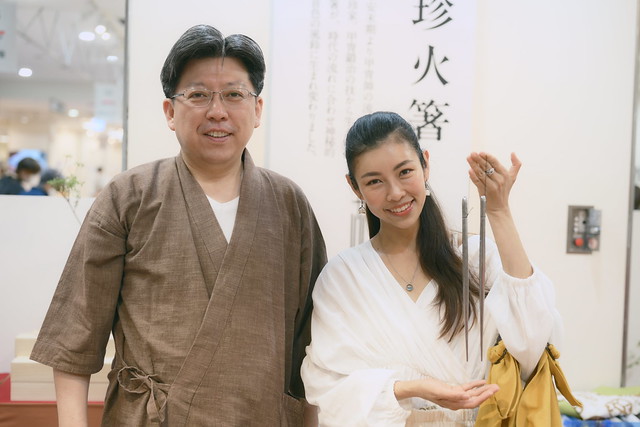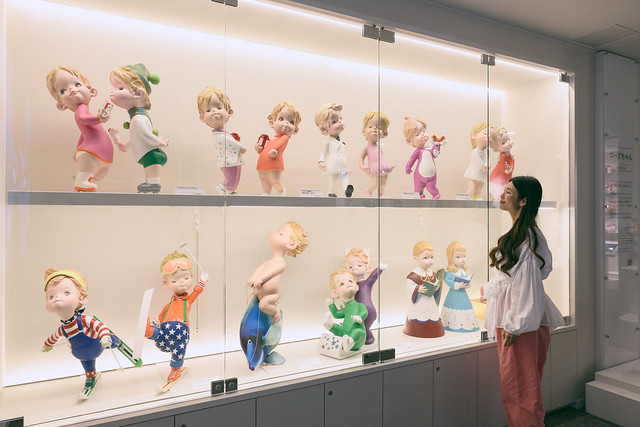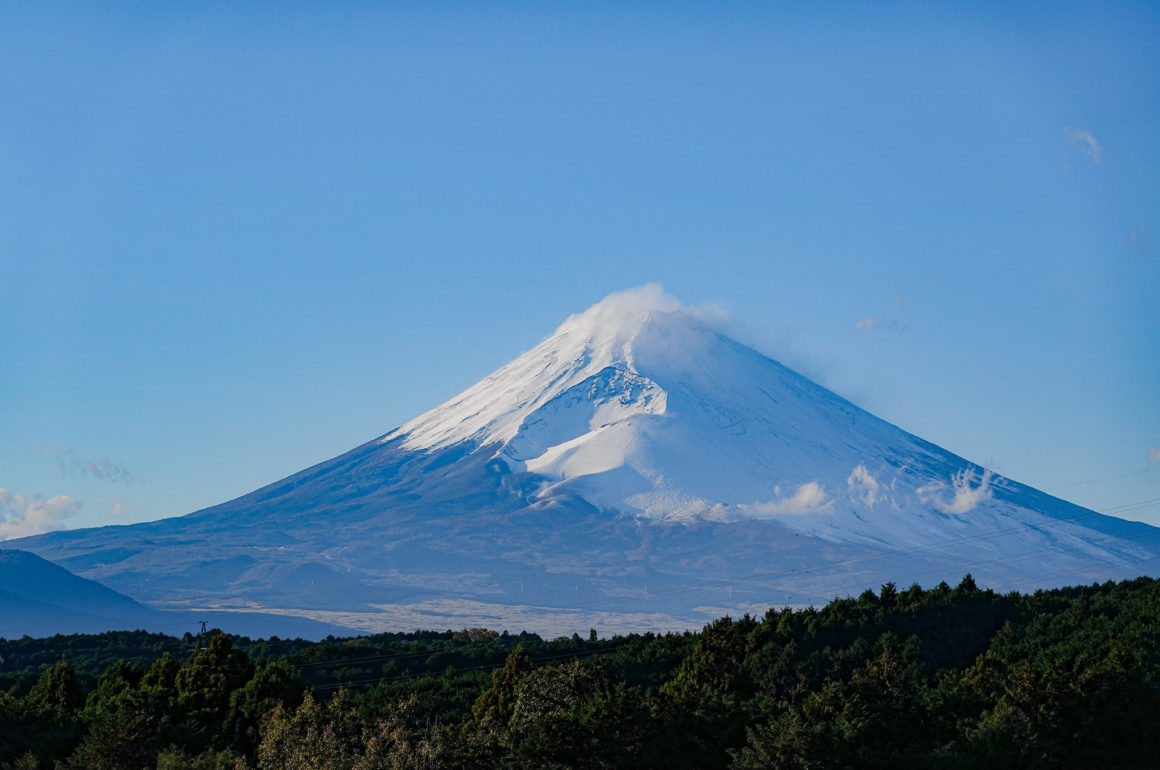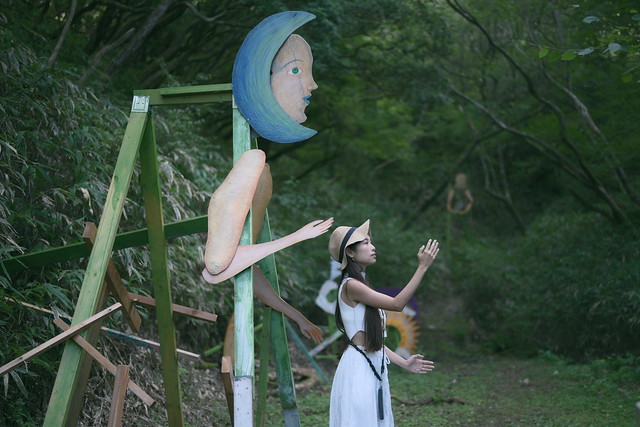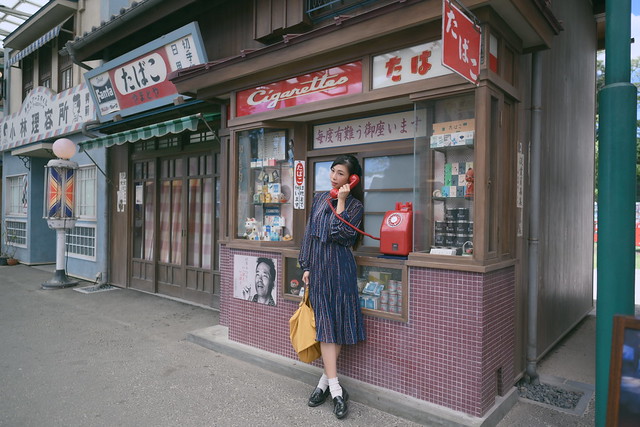
Sado island is part of Niigata prefecture and is really well-known throughout Japan for its rich history and many stories benhind, but due to its remote location, this treasure trove of an island remains one of the best hidden gems in the country. I am so glad and honored to have the chance to visit this precious island not just once, but twice, creating lots of fond memories that will last a long time.
Read my previous blog post on 24 things to do in Niigata:
Sado is the largest island in the Sea of Japan, and just to give you perspective, the land area covers 855 square km so the island itself is larger than the whole of Singapore.
Sado’s symbol and mascot – Toki
Once you arrive at Sado, a giant bird with red face greets you with open arms wings. This is “toki” Japanese name for a crested ibis – a breed which once went extinct in Japan.
Allow me to tell just a little side story, in hope to help you understanding Sado better and when you see one next time, it’s your lucky day!
Toki feed on small creatures such as river snails that inhabit in rice paddies, however the number of birds drastically decreased mainly due to overhunting as well as also partly because of that the use of pesticides and other agriculture chemical was harmful to the birds. Conservation efforts were made but the remaining 10 wild ibises soon died one after another. The last bird died in 2003 and toki went extinct in Japan.
It was not until exactly 20 years ago that the first chick was successfully bred from the Sado Japanese Crested Ibis Conservation Center with artificial breeding using a pair of ibises on loan from China, and have been growing to around 426 birds flying freely in the wild as of Jan 2020.
Sado has vast rice fields and it’s not a rare sight to spot a colony of ibises around the fields. I have seen them a few times during my short stay in Sado. So if you see an ibis near by a farm, you know that you are back to pure nature that’s free of contamination. Every effort is made to not to use harmful chemicals in the paddy fields in order to provide the ibises with a safe habitat.
Many company brands in Sado picked Toki as their mascot or logo, as a symbol of pureness and health. One of the sake breweries I visited (Hokusetsu, you will read about it later) has photographs of beautiful ibis chilling at the rice fields framed in their hall, to show how proud they are of their good quality rice grown without the use of pesticides and chemical fertilizers, even the ibises enjoy them happily. It was a good message sent across.
So, in a way ibises have made Sado island famous because of its rarity. The people in Sado believed that people might not have been so interested in Sado if they didn’t have the toki. They might have saved the birds from extinction but now the birds are saving them by bringing people into this hidden gem of an island…
T_____T.
Oh. Japan. My heart.
Access

I can’t believe I wrote over 500 words just for introduction. Anyway, let’s sort out the logistic! Here’s how you can get to Sado Island.
Well. Sado is the largest isolated island in Japan. So the only way you can venture into this mysterious island is through the sea at the moment although they are looking into restarting the airport operation (let’s hope so!). There are 2 options:
1. Sado Kisen Ferry – it takes about 2.5 hours and is relatively cheaper
2. Sado Jetfoil – it takes merely an hour but it’s a lot more expensive.
To be honest, I really love Sado I think it’s such a hidden gem I worried that the steep price of the transport would deter travelings from making the move, but I was told that there are several ways to make the best out of your Niigata trip!
You can look out for value tickets that give you great discount and benefits such as:
1. SADO GOLD PASSPORT
JPY5500, includes round-trip Kisen ferry, 3 days regular bus in Sado island as well as one day Niigata City Loop Bus. Just top up if you want to ride the jet foil instead (totally ecommended).
You can get it at “Yamazaki Shop”, 1st floor of Niigata Airport, General Information Counter on the 3rd floor of Sado Kisen Niigata Port Terminal as well as Nippon Travel Agency in front of JR Niigata Station.
Website: http://niigata-sado.co.jp/passport/guide-en/
2. Sado-Joetsu Pass or Sado-Niigata Pass
It’s a great value-pack for JR East Pass and JR-West Rail Pass or Hokuriku Arch Pass holders.
Sado-Joetsu Pass is JPY7000 for Echigo TOKImeki Railway Pass, return bus pass between joetsumyoko station and Naoetsu port, round trip Sado kisen ferry and Sado 3-day bus pass. (However do note that this pass is not usable in winter as there’s no operation of boats at Ogi port during winter period)
Sado-Niigata Pass is JPY4000 for Niigata Loop Bus return bus pass from Niigata Station to Niigata Port, round trip Sado Kisen ferry and Sado 3-day bus pass. (Note that this pass is JPY4000 till 31st March 2020. There will be a price increase from 1st April 2020 and will cost JPY5000.)
Website: https://sado-pass.visitsado.com/
After arriving the island, your best bet is a rental car. There’s no rail transport and while there’s bus network shuttling you between places, do try renting a car for your best comfort and flexibility. Cycling is another good way for short-distance sightseeing!
1. Taraibune ride into the anime world
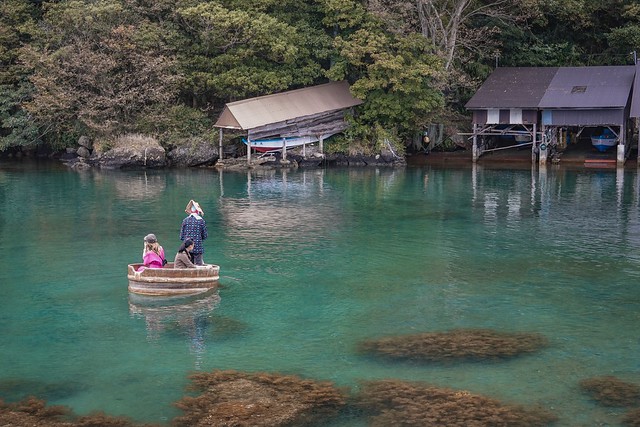
The reason this attraction tops my list is that it was truly won the “Most Unique Sado Experience” for me. Found only exclusively in Sado, Taraibune is a wash-tub boat invented by local fishers in the days gone by to look for turban shells, seaweed and other kinds of seafood in the Ogi area.
Also another thing that I didn’t realize until my followers pointed it out – Hey that’s the Spirited Away boat!!
Remember this?

Exactly!!
Here are Sado, you can immerse yourself into an anime scene from your favorite Ghibli masterpiece and sail away in the crystal clear water. As blue as that in real life.
Yajima Taiken Koryukan 矢島体験交流館

You can find several places to ride Taraibune operated by local villagers. This one is run by several old ladies wearing a huge folded hat and their Taraibune has a glass panel in the middle of the boat so you can see right through the azure clear waters!

You also get a try at maneuvering the taraibune yourself, although it looks much easier than it actually is.
Hangiri Shukunegi Taraibune

There’s this other taraibune place just right across Shukunegi (see next attraction later), called Hangiri. The boats are operated by an old man instead and the bonus about this ride is…

Asti the police shepherd. Yeap. He jumps into the boat with you if you let him.

Your captain will also give you a handful of yummy treats so Asti can be entertained and stay right by you for photos.

I find his explanation a lot better and I steered much smoother this time around!
Watch a video of me steering with Asti on board:
Fee: JPY500 – JPY2000, depending on the course and operator, recommended to go on a longer course, just to support the locals. They are really undercharging their customers. 🙂
2. Peek into the past of a shipping village at Shukunegi 宿根木
Shukunegi flourished as a base for the shipping industry from Edo period to Meiji period using sengokubune – large wooden trading ships.
You can explore this charming town on foot and this is the most photogenic spot: Triangle House.

Sankakuya – lieterally triangle house, is made to fit this narrow corner lot and ended up uncannily resembling that of the bow of a ship. Coincidence? I’m not very sure!

I actually visited Shukunegi twice, in October and in November. Here’s a contrasting two shots during different season, different time of the day.
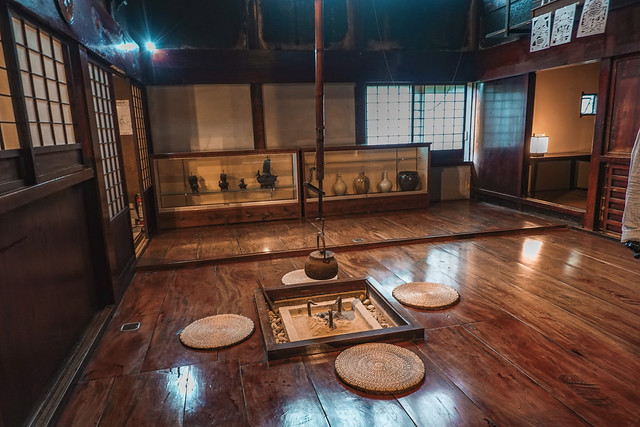
There are a few houses that’s actually open for public that you can visit, such as this Seikuro Open House.

Take the chance to peek into the lifestyle of one of the rich shipping agents in the yesteryears.
Website: http://shukunegi.com/en/
3. Ogi Folk Museum & Sengoku Ship Museum

The Ogi Folk Museum is actually housed in the former Shukunegi Elementary School, and upon entering a gigantic trading ship greets you. It has a cargo-capacity of 1000 “koku” (150 tons), and 1000 “koku” = “senkoku” (千石).

You will see all sorts of exhibition consist of folk materials assembled all over Sado. And they are all sort of just randomly arranged against each other, as if it was a storage from the past.

Bento boxes.

They also preserved a room from the school as it was.
4. Eat Burikatsu Don

Buri – Yellowtail is a Sado specialty, and while on the island you may want to try out its local food – Buri Katsudon – deep fried yellowtail cutlet, served with local Koshihikari rice!
5. Experience Taiko with world-famous Kodo

Well this is totally a #cheesiething, I am biased, yes, but if you have some time to spare on the island, this is a great chance for you to feel a small slice of what drove my passion for Taiko.

Reason?
Well, Sado is a huge island, which means there’s plenty of space for you to drum away without having to worry about a thing. The taiko studio I frequent is in Tokyo and it’s pretty small and confined. Imagine drumming in this warmth-exuding wooden hall that overlooks the lush nature of Sado!

My instructor, Sami, is an actual member of Kodo and she gives the funnest taiko lesson!
Watch a video of my giving a try drumming the 600 year old hollow Keiyaki (zelkova tree) log.
Fee: JPY2000 per adult for a 1-hour lesson
Website: https://www.visitsado.com/en/spot/detail0047/
6. Relaxing walk at Senkakuwan Bay 尖閣湾

This area belongs to part of Sado-Yahiko-Yoneyama Quasi National Park.

Me attempting to pose for one of those so-small-you-can’t-see-me scenery photos.

Another one of those photos captioned “I want to stay here forever”.

Interestingly, this spot is the filming location for the movie “Kimi No Na Wa”… unfortunately it wasn’t the one we know. But an older series with the same name that was popular in the 90s.
Over at Sankakuwan Bay you may also enjoy incredible undersea views from a glass-bottom boat.
7. Join a brewery tour
Manotsuru Obata Brewery 真野鶴酒造

There are a few breweries that welcome visitors in Sado island, and the first one I went to was Manotsuru, a brewery that produces award winning sake for over a century.

Just like I have mentioned in the beginning of this post, one of Manotsuru’s missions is to keep a beautiful and safe environment for the crested ibis, with their contracted rice farmers growing rice with methods that help to nurture living things.

And their sake is made with that method.
Manotsuru conducts brewery tour in English, so if you are looking for a visit, drop them an email!
Website: https://www.obata-shuzo.com/en/
Hokusestu Brewery 北雪酒造
Know the world-renown chain restaurant Nobu by its namesake chef and Robert De Niro? Well, their premium house brand sake is made right here, at Hokusetsu Brewery, Sado.
Taste aside, one distinctive difference that sets its sake apart was that… wait a minute, what was that music I hear?

Well, the sake here listens to music.
Ok I’ll say it again. There’s smoothing, classical music playing throughout the storage room, to help the sake mature. Wait, what? How? You might have heard about that for cattle and even vegetables, but… sake in a bottle??
Well, it is said that the ultrasound and vibration of the music would aid the maturing process of the sake, providing a better flavor in the long run.

Note also that Hokusetsu produces really, really good amazake (sweet non alcoholic rice wine).

And even better umeshu. The umeshu here, instead of mixing it with liquor, Japanese sake is added, providing a milder and less sweet, but definitely more flavorful accent to the plum wine. I loooove it!
Website: https://sake-hokusetsu.com/
8. Stuff your face on all-you-can-eat crab!
This place is so awesome I just had to add an exclamation mark behind.
I have a good news and a bad news.
The good news is, congratulations, you just discovered probably the most worth-your-money crab buffet in the whole of Japan.
The bad news is, well, if even one of you even successfully make it there, it’s quite a miracle.

The thing is, there isn’t really a signboard leading to the building. In fact, I wasn’t even sure what it was called. The official name for this building is “Akadomari Tourist Center” (赤泊観光センター), which is not written anywhere in the building (or at least can’t be clearly seen). There’s also no colorful signs like those see in Osaka’s Dotonbori shouting “CRAB BUFFET!!!”. Well, at least the purple banner says “eatery” and the red one says “in business”. That’s all you need to know.

Attaching this photo as proof, in case no one believes me haha.
The crab buffet is available from October to May each year, reservation needed. Do note that it’s not available in Jan and Feb as it is breeding period and they wanna avoid catching baby crabs. It’s JPY2250 (about SGD28) for as much crab as you can stomach, and comes with 2 drinks.

It’s also a little sad to know but there was actually a port called the Akadomari port nearby for ferries to come in, along with Ogi Port and Ryotsu Port, which explains the need for a tourist center. However the port was closed due to decreased traffic, and how this tourist center still functions until today is a mystery to me.
Which is why I felt such a struggle eating the crab – I want to enjoy my best self but I don’t want them to run out of business – so should I eat less or eat more????
Haha. Anyway I was told that that’s really how much crab Sado produces so feast your heart out!
Watch a timelapse video of me eating crab:
Website: https://www.visitsado.com/en/spot/detail0335/
9. Visit the Sado Gold Mine

As a classic attraction in Sado, you can expect to understand how gold mining is done, with easy-to-understand robotic illustration and walk through parts of real gold tunnel from some 400 years ago!

In Sohdayu Mine, you may observe how miners work deep underground, digging and digging by hand.
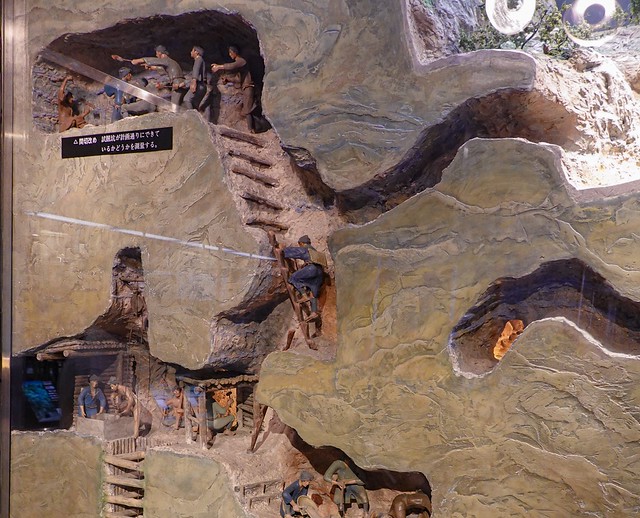
Sado has the biggest gold and silver mine in Japan. There are many gold veins and the major eight large gold veins stretched 3km east to west, 600m north to south and 800m deep. The total length of the tunnels reach 400km long – as far as the journey from Sado to Tokyo!! Isn’t that crazy?

This is Dohyu No Wareto, look at the split mountaintop that caved-in after being mined by hand in pursuit of gold and silver. Our guide jokingly said, “humans are so greedy they can split mountains by hand”. I guess he was not wrong.
Even though the gold mining stopped in 1989 due to exhausted resources, it is believed that there are still gold inside the mountains and deep sea of Sado island, so perhaps one day, there will be a day of gold rush again in Sado.
10. Kitazawa Flotation Plant Ruins

The Kitazawa Flotation Plant Ruins is said to resemble another famed Ghibli production – Laputa: Castle in the Sky.
This is the remains of the processing facilities construction in 1938 to extract gold. Now it is no longer in use and is covered in lush green looking like the said floating castle, making a great Instagenic spot for artistic snapshots.
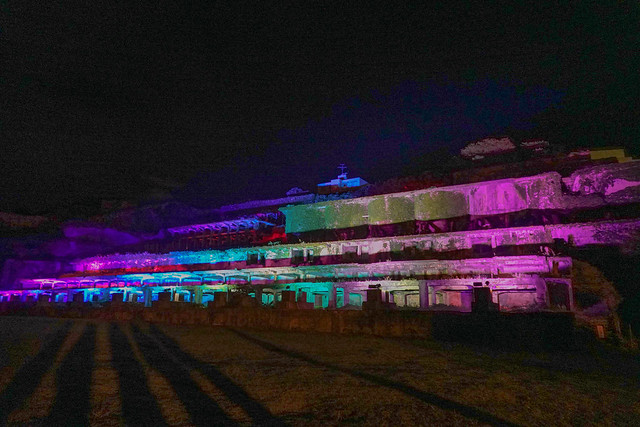
In night time, it is also lit up in multi-colored illumination, so even after sundown you are able to enjoy a piece of Sado’s goldrush.
11. Hunt for some real gold at Nishimikawa Gold Park 西三川ゴールドパーク

Other than Sado Gold Mine, Nishimikawa is your must-visit facility for a hands-on experience on… finding real gold dust!!

Being the oldest facility on the island, it has a comprehensive hall about the history and trivia about gold. For example, see the tiny bit of gold on the red tray? That tiny bit can produce a 3000 meter long gold thread (!?) that you see in the photo. It is to proof that gold is a soft and bendable material that could be easily stretched and flattened.
Trivia – Did you know? The Tokyo Olympics Gold Medals are made from recycled electronic. Over 47,000 tons of tech waste were gathered to create what the athletes will be hanging around their neck next year. Japanese citizens donated over five million cell phones to the effort. Oh Japan…

There’s also lots of real gold in the facility. I’m guessing Sado is too remote and peaceful as a break-in target hahaha.

Anyway, here’s the main highlight!! I just wanted to make sure that you don’t skip the information hall and jump straight to hunting for gold, as the very very friendly and kind guide of the facility told us with a sad face.

Here, you get to experience gold panning. Basically you will be given a sieve and you will scoop through the water and to the bottom of sand (the water temperature is adjusted to be warm during winter for the guests’ comfort. Oh Japan… T__T), and then slowly try to sift out the sand leaving only bits of gold dust behind. This technique is called gold panning.

With a little help, this is how much gold I have collected!!

You can then bring back the gold in the bottle or have it framed up in a keychain or as a pendant for a small fee. I had mine made into a necklace and I love it!!
Website: https://www.visitsado.com/en/spot/detail0009/
Fee: JPY800 (isn’t it too cheap?? For that much of real gold???)
12. Mumyoi Pottery Experience 無名異焼

Yeap, even I had problem pronouncing the name “Mumyoi”. I totally call it “mom-yoh-yee” but of course, it is Japanese, so it is called “mu-myo-i”. How important hyphens are. Haha.
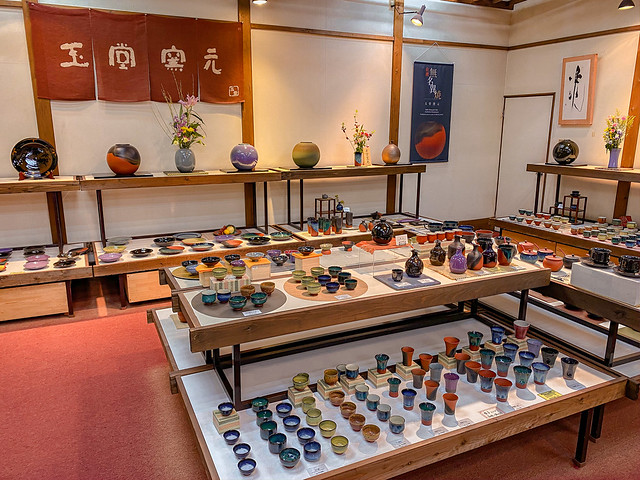
The shop is called Gyokudo Kamamoto 玉堂窯元. While I don’t have much experience in pottery, I was impressed by how long the process takes just to create a mumyoi ware. What’s so unique about mumyoi ware is that it is a lot more solid and tougher than many ceramic ware, and although it is made clay, it actually produces a metallic sound when you flick it with your flinger.
Since olden days, the Mumyoi clay is thought to have medicinal properties to relieve palsy stomach and bowel disorders etc, so the people in Sado believe that there are health benefits by just consuming your drinks and food in a mumyoi ware.

You can try your hands on mumyoi pottery here, and choose from a selection of rice bowl and cups.

I never understood pottery, but after just one experience, I could understand why some people are so into it. Somehow it has a very soothing effect that lets you really concentrate and be in the moment. Give it a try!
Website: https://www.gyokudou.com/en/mumyoiyaki-en/
13. Meet the rabbit-loving monk at Rabbit Temple

Upon arrival you will see that… there’s nothing that tells you that it is a temple. 
You will see instead, a giant rabbit statue.

Chokokuji Temple 長谷寺, despite its ultra cute nickname, is actually thought to have been found in year 807.
How this temple became the rabbit temple was rather straightforward, and I actually learnt it from Japanese TV program one day – the visitors to the temple has been decreasing and the monk, who kept a bunch of rabbits thought about building a giant rabbit statue to attract new visitors.

Do expect it to be a rather unusual temple – I spotted daikon with leaves. Lots and lots of leaves.
Also, there’s also another rather unusual experience for you – only if you dare! Enter a real coffin and listen to the chants of the monk, trying to feel a moment between life and death, and come out reborn.
Where to stay
Yahatakan 国際佐渡観光ホテル八幡館

Sado makes a great relaxing getaway so while you are here, an onsen ryokan sounds just about right.

“Enough of crab!!” Says no one ever.
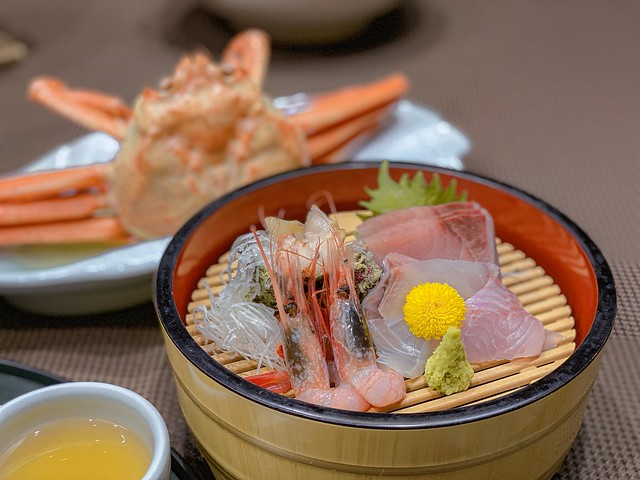
Enjoy Sado’s freshest seafood in the comfort of your ryokan yukata.

The simplest dessert – frozen permission, just in season.

And dip in the therapeutic spring to get rid of all travel fatigue, ready for your next journey.
Website: http://yahatakan.com/english/index.html
That’s all for Sado this time. Till then, I’m sure I will have more of Niigata to come in the near future. 🙂



